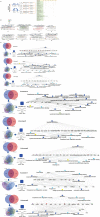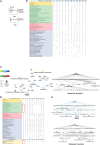Changes in the urinary proteome before and after quadrivalent influenza vaccine and COVID-19 vaccination
- PMID: 36275736
- PMCID: PMC9585259
- DOI: 10.3389/fimmu.2022.946791
Changes in the urinary proteome before and after quadrivalent influenza vaccine and COVID-19 vaccination
Abstract
The proteome of urine samples from quadrivalent influenza vaccine cohort were analyzed with self-contrasted method. Significantly changed urine protein at 24 hours after vaccination was enriched in immune-related pathways, although each person's specific pathways varied. We speculate that this may be because different people have different immunological backgrounds associated with influenza. Then, urine samples were collected from several uninfected SARS-CoV-2 young people before and after the first, second, and third doses of the COVID-19 vaccine. The differential proteins compared between after the second dose (24h) and before the second dose were enriched in pathways involving in multicellular organismal process, regulated exocytosis and immune-related pathways, indicating no first exposure to antigen. Surprisingly, the pathways enriched by the differential urinary protein before and after the first dose were similar to those before and after the second dose. It is inferred that although the volunteers were not infected with SARS-CoV-2, they might have been exposed to other coimmunogenic coronaviruses. Two to four hours after the third vaccination, the differentially expressed protein were also enriched in multicellular organismal process, regulated exocytosis and immune-related pathways, indicating that the immune response has been triggered in a short time after vaccination. Multicellular organismal process and regulated exocytosis after vaccination may be a new indicator to evaluate the immune effect of vaccines. Urinary proteome is a terrific window to monitor the changes in human immune function.
Keywords: COVID–19; QIV; proteome; urine; vaccination.
Copyright © 2022 Pan, Liu, Bao, Wei and Gao.
Conflict of interest statement
The authors declare that the research was conducted in the absence of any commercial or financial relationships that could be construed as a potential conflict of interest.
Figures




Similar articles
-
Safety and immunogenicity of a high-dose quadrivalent influenza vaccine administered concomitantly with a third dose of the mRNA-1273 SARS-CoV-2 vaccine in adults aged ≥65 years: a phase 2, randomised, open-label study.Lancet Respir Med. 2022 Apr;10(4):392-402. doi: 10.1016/S2213-2600(21)00557-9. Epub 2022 Feb 1. Lancet Respir Med. 2022. PMID: 35114141 Free PMC article. Clinical Trial.
-
[Technical guidelines for seasonal influenza vaccination in China (2022-2023)].Zhonghua Yu Fang Yi Xue Za Zhi. 2022 Oct 6;56(10):1356-1386. doi: 10.3760/cma.j.cn112150-20220825-00840. Zhonghua Yu Fang Yi Xue Za Zhi. 2022. PMID: 36274602 Chinese.
-
A randomized, double-blind, placebo-controlled phase III clinical trial to evaluate the efficacy and safety of SARS-CoV-2 vaccine (inactivated, Vero cell): a structured summary of a study protocol for a randomised controlled trial.Trials. 2021 Apr 13;22(1):276. doi: 10.1186/s13063-021-05180-1. Trials. 2021. PMID: 33849629 Free PMC article.
-
[Technical guidelines for seasonal influenza vaccination in China (2021-2022)].Zhonghua Liu Xing Bing Xue Za Zhi. 2021 Oct 10;42(10):1722-1749. doi: 10.3760/cma.j.cn112338-20210913-00732. Zhonghua Liu Xing Bing Xue Za Zhi. 2021. PMID: 34814607 Chinese.
-
Insights into COVID-19 Vaccine Development Based on Immunogenic Structural Proteins of SARS-CoV-2, Host Immune Responses, and Herd Immunity.Cells. 2021 Oct 29;10(11):2949. doi: 10.3390/cells10112949. Cells. 2021. PMID: 34831172 Free PMC article. Review.
Cited by
-
Does COVID-19 Vaccination Cause Storage Lower Urinary Tract Symptoms?J Clin Med. 2022 May 12;11(10):2736. doi: 10.3390/jcm11102736. J Clin Med. 2022. PMID: 35628863 Free PMC article.
-
Urological complications after COVID 19 vaccine according to age, sex and manufacturer.World J Urol. 2023 Aug;41(8):2255-2263. doi: 10.1007/s00345-023-04481-1. Epub 2023 Jul 3. World J Urol. 2023. PMID: 37400660
References
-
- Xiao X, Zou L, Sun W. “Human Urine Proteome: A Powerful Source for Clinical Research,” In: Gao Y, editor. Urine. Singapore: Springer Singapore; (2019). p. 9–24.
Publication types
MeSH terms
Substances
LinkOut - more resources
Full Text Sources
Medical
Miscellaneous

